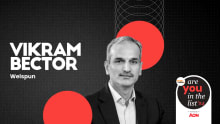Looking beyond the 'personality' cult

Volatility, uncertainty, complexity and ambiguity (VUCA) are attributes of the hyper competitive world in which leaders operate today. In India and across Asia Pacific, these challenges are amplified by the speed of change and the risks associated with the competitive landscape. This requires leaders who are agile, humble tested performers who have learnt to generate success through others.
Our work with the most senior leaders in APAC and across the globe has identified four of the most complex challenges facing leaders: Leading and extending influence across multiple groups and constituencies; Addressing strategy in a way that clearly results in action and culture change; Achieving talent sustainability (next generation talent management); Driving operational excellence and achieving continued business results.
The interdependent leadership
In today’s context, leadership is not only the task of an individual, but the combined actions produced by all the organisation’s members to ensure ideal direction, alignment and commitment.
A 2012 IBM CEO study reveals that companies that outperform their peers are 30 per cent more likely to identify openness, which enables collaboration and innovation as a key influence on their organisation.
Companies need to understand that leadership can no longer be kept with those already in such a role, or a group of individuals based on knowledge and expertise; it is more of a collective activity that instills mutual inquiry and learning. We term this openness and collaborative culture as interdependent leadership culture. This leads to a wider use of dialogue, collaboration, horizontal networks, valuing of differences and a focus on learning.
The key to building an interdependent leadership culture is collaboration. And to collaborate effectively, leaders need to be comfortable at spanning boundaries and letting go of the silo mindset. Boundary spanning requires a leader to:
- Manage boundaries – establish, clarify and respect the boundaries
- Forge common ground – integrate to build trust, engagement and shared ownership across boundaries
- Discover new frontiers – collaborate to support breakthrough of innovation, transformation and reinvention
The right approach
It can be said that many of the best practices in leadership development, which are anchored on learning from experience, remain the same. However, it is the approach that needs a makeover from time to time.
Keeping in mind the challenges of the complex world, it is necessary to design interventions that revolve around how to accelerate effective development of key individual, team and organisational behaviours. It is also necessary to integrate these with business realities.
Nowadays, leadership interventions in top organisations are increasingly working towards using network analysis to enhance the strength of human capital networks, increasing the speed of innovation within teams and functional groups. Another strategy that many top organisations have started to use to their benefit is the neuroscience of leadership. The neuroscience of leadership takes into account the physiological nature of brain and helps develop practices, which resonate with the human brain and response to various aspects of leadership.
What can organisations do?
Past leadership behaviours and laurels only reflect extension of status quo. What is required is how leaders expand their capacity to be open, agile and mindful in these VUCA times.
While confidence in the plan is essential, an over-reliance on strategy without an equal commitment to culture and talent is like a three-legged stool with only one functioning leg. Starting from the top, leaders need to conscientiously set aside time to reflect on the organisational culture & leadership requirements that would make the business strategy possible.












